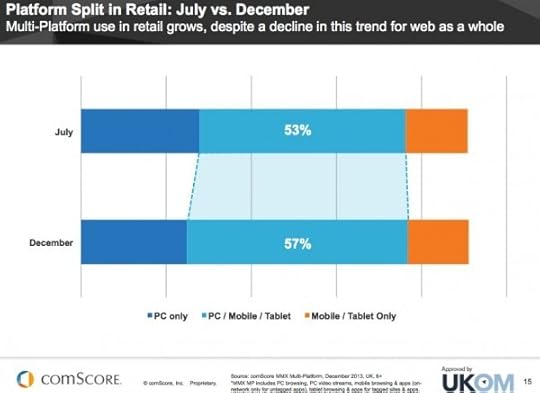The Medium Is the Message: The Importance of Tracking Analytics across Devices

A recent report by comScore shows mobile devices accounted for 55 percent of online usage in the U.S. as of January, 2014, with apps making up 47 percent of traffic. With mobile users officially tipping the scales in search, marketers can’t afford to ignore the analytics and keep focusing on traffic and conversions from PC usage. Here’s a look at growing trends in search, consumer behavior and what’s driving content marketing.
Multi-platform tracking
In the early days of social media, experts would point to engagement numbers and reach as the most practical way to measure ROI. But it’s no longer enough to sit back and wait to see how your traffic shakes out and converts into paying customers and loyal fans. The digital landscape is rapidly changing from simply browsing from a PC, to mobile and beyond.
A 2014 market report by comScore shows the majority of consumers are multi-screening across mobile or desktop to shop online. Customers need a cohesive experience whether using their laptop, desktop, tablet, smartphone or otherwise. Optimizing a website for a smartphone requires a deep understanding of how users are browsing on their phones, how the layout of your site looks on a mobile device, if visitors can clearly read and click on information and what they’re searching for.
It’s not enough to simply give consumers a variety of ways to interact with your brand. Marketers need to look to multi-platform tracking to monitor traffic and conversions from our ever-changing digital climate. Google is already offering Universal Analytics for mobile app, gaming consoles and information kiosks tracking to figure out how users are actually interacting with information. KISSMetrics and moz Analytics are also good places to start with traffic monitoring.
Give consumers content where they want it
It’s tempting to think you can just continue on with the status quo since it’s been working this long. But not knowing where, how and why your users are interacting with your content means a missed opportunity to give them content where they use it most. If your customers are all looking for reviews on Yelp from their mobile devices, you can plot your next steps accordingly. Incorporate social media reviews into your marketing plan or buy Facebook ads to meet your audience where they look for you most.
Think bigger than traffic sources leading back to your site, and anticipate where consumers will go next. Research from the Google Shopper Marketing Agency Council shows 79 percent of smartphone owners are also avid smartphone shoppers. Ninety-percent of those use their phones for pre-shopping activities like finding promo codes, looking up store hours, and finding product information. Consider keeping your audience engaged by leaking promo codes and ensuring essential shopping information, like your return policy, are easily accessible via smartphone browsing.
And according to Google’s Mobile Path to Purchase report, 84 percent of smartphone shoppers use their devices to help them make purchases while still in the store, across everything from appliances down to pet care. They also found shoppers using mobile actually bought more than those without their phones. Tracking consumer behavior on mobile, and any device, is crucial to give your consumers what they want. Otherwise, they’ll simply find a search result to answer it for them and potentially take their business elsewhere.
How will customers find you?

How consumers end up on your website or other digital property is just as important to consider as what devices they’re using. According to Google’s mobile path to purchase report, 48 percent of those surveyed start their search on search engines, 33 percent start on a branded website, and 23 percent launch a search from a branded app. Neglecting any of the three could alienate a large percentage of potential customers.
While the report tells us search engines are still king, the rules have changed. Publishing a blog and writing consistent copy got companies ranked sooner than later. Today, brands need a carefully planned and executed content marketing strategy to rank for search. Ebooks, reports, podcasts, giveaways and the rapid rise of video all working together to raise brand awareness can improve your search results. But creating even the most valuable content can’t exist in a vacuum. Every piece of content you create also needs to be found online to work. This means using social media, building relationships with influencers and consistently promoting every piece of content is a necessary step towards getting found online.
Thumbnail: http://tinyurl.com/ljpordy
[image error]





